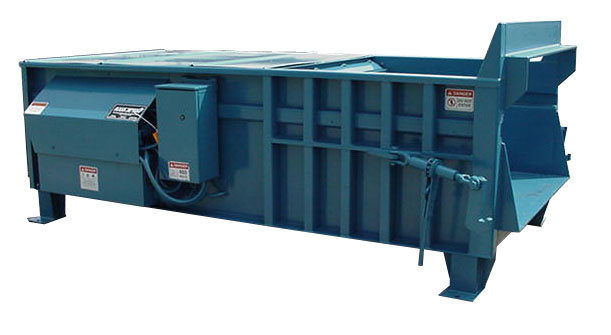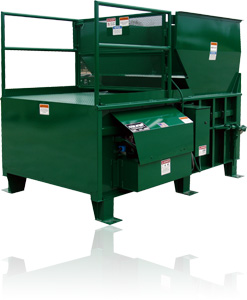Commercial trash compaction equipment and its role in reducing waste volume
Recognizing the Various Uses of Waste Devices in the Recycling Sector
The reusing sector relies greatly on specialized waste equipment to optimize processing and recovery. Each device, from shredders to balers, serves a distinctive function that enhances general efficiency. Recognizing these functions is necessary for improving sustainability initiatives. Commercial garbage compaction equipment. As modern technology advancements, new developments arise, assuring to change standard techniques. This advancement elevates important concerns concerning the future of waste management and its effect on ecological preservation. What modifications exist ahead for this vital industry?
The Function of Shredders in Product Handling
Shredders play a crucial role in the recycling industry by effectively processing various sorts of waste materials. These devices are designed to reduce huge items, such as plastics, metals, and organic waste, into smaller, manageable pieces. This size reduction is essential for succeeding recycling processes, as it permits for much easier handling and sorting. In enhancement to assisting in recycling, shredders boost safety by reducing the risk of injury associated with managing bulky waste things.
Shredders add to environmental sustainability by ensuring that materials are refined in a way that makes the most of resource healing. They can handle a varied series of materials, making them flexible tools in waste monitoring facilities. The reliable procedure of shredders not just simplifies the reusing process yet additionally enhances the total efficiency of waste diversion efforts, promoting a circular economic situation. Their value in material processing can not be overstated, as they function as a foundational step towards lasting waste monitoring techniques.

How Balers Enhance Effectiveness in Waste Administration
Balers significantly improve efficiency in waste administration by compacting various products into bundles, which streamlines storage space and transport. By compressing recyclables such as cardboard, plastics, and steels, balers substantially reduce the volume of waste. This compression not only makes best use of space in reusing facilities but likewise reduces the number of trips required to move materials, resulting in lower fuel costs and decreased environmental impact.
Additionally, balers add to enhanced safety and security in waste administration operations. Small bales are easier to stack and take care of, decreasing the danger of crashes related to loosened products. The uniform dimension of bales permits more effective filling and unloading procedures, enhancing operations within reusing centers. Additionally, balers can improve the overall quality of recyclables, as properly compressed materials are less likely to be infected. Generally, balers play a necessary function in enhancing waste management practices, promoting sustainability in the reusing industry.
Conveyor Systems: Enhancing the Recycling Process
Integrating innovative equipment like balers greatly boosts waste monitoring procedures, however the performance of the reusing procedure is further enhanced through making use of conveyor systems. These systems play a necessary duty in the smooth transportation of materials within recycling facilities. By promoting the motion of different waste types, conveyor systems minimize manual handling and minimize the risk of contamination throughout the reusing procedure.
Conveyor systems can be personalized to fit the one-of-a-kind formats and operational needs of reusing centers. Their ability to run constantly enables a stable circulation of products, enhancing efficiency and making sure that arranging and processing tools receives a consistent navigate to this website supply.
Outfitted with attributes like flexible speeds and automated controls, conveyor systems can maximize the circulation of materials, considerably improving general efficiency (Commercial garbage compaction equipment). As a result, these systems are crucial in modern-day recycling procedures, adding and improving procedures to effective waste administration
Sorting Machines: The Key to Material Healing
Arranging equipments are essential parts in the recycling market, greatly boosting the performance of material recuperation. These machines play an essential duty in the splitting up of various recyclable materials, allowing for a streamlined process that makes the most of source removal. By utilizing sophisticated modern technologies, such as optical sensing units and air classifiers, arranging equipments can determine and classify products based upon their composition, weight, and size. This capacity ensures that steels, plastics, and paper items are effectively isolated, lessening contamination and enhancing the quality of recycled outcome.
The procedure of arranging machines considerably minimizes the dependence on hands-on labor, which right here can be both lengthy and susceptible to mistakes - Commercial garbage compaction equipment. In addition, the automation offered by these devices increases the overall recycling procedure, bring about greater throughput and raised operational effectiveness. As a result, arranging equipments are essential in accomplishing sustainable waste administration goals, making it possible for the recycling industry to properly recoup valuable materials while lowering garbage dump reliance

Technologies in Waste Equipment for a Sustainable Future
Recent developments in waste tools are driving the reusing sector toward a more lasting future. Advancements such as automated arranging systems, which use expert system and equipment learning, improve performance by accurately recognizing and dividing recyclables. This leads to greater healing rates and lowered contamination. Furthermore, growths in compacting technology enable extra reliable transport of materials, lessening carbon impacts during transportation.
Additionally, improvements in shredding devices enhance the processing of complex materials, enabling the recycling of items that were when deemed non-recyclable. The assimilation of renewable resource resources, like solar energy, in waste handling centers additionally contributes to sustainability objectives. On top of that, developments in eco-friendly products and waste-to-energy modern technologies are improving the landscape of waste management. Jointly, these innovations represent a transformative change within the reusing industry, promoting not just environmental management however additionally financial feasibility for future generations.
Regularly Asked Inquiries
What Sorts Of Materials Can Waste Devices Deal With?
The sorts of materials waste equipment can take care of consist of plastics, metals, paper, glass, and organic waste. Each devices type is designed for certain products, maximizing efficiency and performance in arranging and refining various waste streams.
Just How Commonly Should Waste Equipment Be Kept?

Exist Security Concerns With Using Waste Devices?
Security issues with making use of waste tools consist of potential injuries from mechanical malfunctions, exposure to unsafe products, and poor training. Correct upkeep, regular evaluations, and employee education and learning are necessary to minimize these threats successfully in any setting.
What Is the Ordinary Lifespan of Recycling Tools?
The ordinary lifespan of reusing devices usually ranges from 10 to two decades, relying on factors such as use intensity, maintenance methods, and technological advancements, which can substantially affect toughness and effectiveness in time.
How Is Waste Devices Powered in Recycling Facilities?
Waste tools in recycling facilities is typically powered by power, though some makers may use alternate energy sources like natural gas or diesel. This power makes it possible for reliable processing and makeover of materials for reusing objectives.
Shredders play a crucial role in the recycling market by effectively refining various types of waste materials. They can manage a diverse array of materials, making them versatile devices in waste monitoring centers. Balers substantially enhance performance in waste administration by condensing various products right into bales, hop over to these guys which streamlines storage and transportation. The types of materials waste tools can manage include plastics, metals, paper, glass, and natural waste. Security worries with utilizing waste tools include potential injuries from mechanical breakdowns, exposure to hazardous materials, and insufficient training.